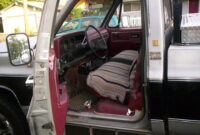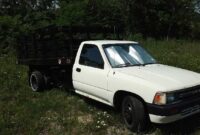1984 Chevy Pickup Trucks For Sale: A Comprehensive Buyer’s Guide pickup.truckstrend.com
The roar of a V8, the iconic lines of a robust workhorse, and the undeniable charm of a bygone era – for many automotive enthusiasts and practical truck owners alike, the 1984 Chevy Pickup Truck represents more than just a vehicle; it embodies a piece of American history and enduring reliability. Part of the revered "Square Body" generation (1973-1987), these trucks have transcended their utilitarian origins to become highly sought-after classics. Whether you’re a seasoned collector, a first-time classic truck buyer, or simply looking for a dependable and stylish vintage hauler, navigating the market for a 1984 Chevy pickup can be an incredibly rewarding journey. This comprehensive guide will delve into everything you need to know about finding, evaluating, and purchasing these magnificent machines.
Why a 1984 Chevy Pickup? The Enduring Appeal of the Square Body
1984 Chevy Pickup Trucks For Sale: A Comprehensive Buyer’s Guide
The 1984 Chevrolet C/K series pickup trucks belong to what is affectionately known as the "Square Body" generation. Characterized by their strong, angular lines, these trucks were built during an era when simplicity, durability, and repairability were paramount. Unlike many modern trucks brimming with complex electronics, the 1984 models offer a refreshing mechanical straightforwardness that appeals to DIY enthusiasts and those who appreciate no-nonsense engineering.
Their appeal stems from several factors:
- Iconic Design: The clean, timeless aesthetics of the Square Body have garnered a cult following, making them instantly recognizable and perpetually stylish.
- Robust Construction: These trucks were engineered for hard work. Their sturdy frames, durable powertrains, and generally overbuilt components mean many are still on the road decades later.
- Mechanical Simplicity: With fewer computers and sensors, diagnosing and repairing issues is often more straightforward, making them accessible even to those with basic mechanical skills.
- Versatility: From a daily driver to a show truck, a workhorse, or a canvas for customization, the 1984 Chevy pickup can fulfill a multitude of roles.
- Nostalgia and Investment: For many, these trucks evoke a sense of nostalgia for simpler times. Furthermore, well-maintained or restored Square Bodies have shown a steady appreciation in value, making them a potentially sound investment.

Key Features and Specifications of the 1984 Models
The 1984 model year offered a range of configurations, allowing buyers to choose a truck perfectly suited to their needs. Understanding these options is crucial when evaluating a potential purchase.
Engine Options:
- 250 cu in (4.1 L) I6: The standard inline-six, known for its incredible durability and fuel efficiency (for its time), though less powerful.
- 305 cu in (5.0 L) V8: A popular small-block V8, offering a good balance of power and economy.
- 350 cu in (5.7 L) V8: The most common and sought-after V8, providing robust power and excellent aftermarket support. Many have been rebuilt or upgraded over the years.
- 6.2 L Diesel V8: A diesel option for those seeking better fuel economy and towing torque, though less common and sometimes more challenging to find parts for specific diesel components.


Transmission Options:
- Manual Transmissions: Typically 3-speed or 4-speed manual options were available, offering direct control.
- Automatic Transmissions: The TH350 and TH400 were common, both known for their durability. The 700R4 overdrive automatic began to appear more frequently, offering better highway fuel economy.
Trim Levels:
- Custom Deluxe: The base model, spartan but functional.
- Scottsdale: A step up, adding some comfort features and chrome trim.
- Cheyenne: Further enhancements in comfort and aesthetics, often with more interior amenities.
- Silverado: The top-tier trim, boasting the most luxurious interior features, extensive chrome, and often power options like windows and locks.
Body Styles & Drivetrain:
- Regular Cab: The most common configuration.
- Extended Cab (Club Coupe): Offered more interior space behind the front seats.
- Crew Cab: Less common in 1984 for consumer sales, but available for fleet or special order.
- Short Bed (6.5 ft) / Long Bed (8 ft): Available across most cab configurations.
- 2WD (C-series): Rear-wheel drive, ideal for street use, lighter weight, and often better fuel economy.
- 4WD (K-series): Four-wheel drive, providing off-road capability and traction in adverse conditions.
Where to Find 1984 Chevy Pickup Trucks For Sale
Finding the right 1984 Chevy pickup requires patience and knowing where to look.
- Online Marketplaces: Websites like eBay Motors, Craigslist, Facebook Marketplace, ClassicCars.com, Hemmings, and AutoTrader Classics are excellent starting points. Use specific search terms like "1984 Chevy C10," "1984 Chevy K10," "1984 Silverado," or "Square Body pickup."
- Specialized Classic Car Dealers: Many dealerships specialize in vintage vehicles. While prices might be higher, these trucks are often inspected, and some offer warranties.
- Auctions: Major automotive auctions (e.g., Mecum, Barrett-Jackson) often feature high-quality, restored Square Bodies. Local and online auctions can also yield good finds.
- Word-of-Mouth & Local Classifieds: Don’t underestimate the power of local connections, car clubs, and community bulletin boards. Sometimes the best deals are found close to home.
- Dedicated Forums and Social Media Groups: Online communities for Square Body enthusiasts are great places to find trucks for sale, often directly from owners who have cherished them.
What to Look For: A Buyer’s Inspection Guide
Before making an offer, a thorough inspection is paramount. If you’re not mechanically inclined, hire a qualified classic car mechanic for a pre-purchase inspection (PPI).
- Rust: This is the number one enemy of Square Bodies. Check:
- Cab Corners and Rocker Panels: These areas are notorious for rust.
- Fender Wells and Lower Fenders: Especially behind the front wheels.
- Bed Floor and Inner Fenders: Look under bed liners if present.
- Frame: Inspect the entire frame for cracks, excessive surface rust, or signs of previous major repairs.
- Underbody: Crossmembers, body mounts, and brake lines.
- Engine and Drivetrain:
- Start-up: Listen for unusual noises (knocking, ticking, excessive smoke).
- Fluid Leaks: Check under the truck for oil, transmission fluid, or coolant leaks.
- Performance: Test drive to assess acceleration, shifting, braking, and steering. Ensure the transmission shifts smoothly.
- 4WD (if applicable): Engage 4WD high and low to ensure it works correctly.
- Chassis and Suspension:
- Steering: Check for excessive play in the steering wheel.
- Bushings and Shocks: Look for worn or cracked rubber components.
- Brakes: Test for pulling, grinding, or a spongy pedal.
- Interior:
- Seat Condition: Rips, tears, or collapsed foam.
- Dashboard: Check for cracks, especially around the speaker grilles.
- Gauges and Lights: Ensure all instruments function.
- HVAC: Test heater and air conditioning (if equipped).
- Electrical: Test windows, locks, radio, wipers, and all exterior lights.
- Exterior:
- Body Panels: Look for dents, dings, mismatched paint, or signs of poor bodywork.
- Chrome and Trim: Assess condition, as replacement can be costly.
- Glass: Check for cracks or delamination.
- Documentation:
- Ensure it’s clean and matches the VIN on the truck.
- Service Records: Any history of maintenance or repairs is a big plus.
Understanding the Price: Factors Affecting Value
The price of a 1984 Chevy pickup can vary wildly, from a few thousand dollars for a project to tens of thousands for a show-quality restoration. Key factors include:
- Condition: This is the most significant determinant. A rust-free, fully restored truck will command a premium over a rusty, non-running project.
- Mileage: Lower original mileage often translates to higher value, assuming condition is commensurate.
- Engine/Transmission: V8 models, especially the 350, are generally more desirable and valuable than I6 or diesel options. Trucks with desirable automatic transmissions (like a 700R4) can also be more attractive.
- Trim Level: Silverado models typically fetch the highest prices due to their enhanced features and comfort.
- 2WD vs. 4WD: Both have their markets, but 4WD models often command a slightly higher price due to their added capability.
- Originality vs. Modifications: While some modifications (e.g., engine upgrades, modern suspensions) can add value to certain buyers, original, unmolested examples are increasingly prized by collectors.
- Geographic Location: Prices can vary based on regional demand and climate (e.g., trucks from dry climates are less likely to have severe rust).
Restoration vs. Driver: Making the Right Choice
Deciding between a fully restored truck, a good "driver," or a project truck depends heavily on your budget, mechanical aptitude, and intended use.
- Fully Restored/Show Quality:
- Pros: Turn-key, beautiful aesthetics, often higher resale value, minimal immediate work required.
- Cons: Highest price point, may be too nice for regular use or hauling.
- Ideal for: Collectors, show enthusiasts, those who want a perfect truck without the effort.
- Good Driver Quality:
- Pros: Usable immediately, can be enjoyed without fear of minor wear, good balance of condition and cost.
- Cons: May have minor cosmetic flaws or require small mechanical tweaks over time.
- Ideal for: Regular use, weekend cruising, light hauling, or a gradual restoration project.
- Project Truck:
- Pros: Lowest initial cost, allows for complete customization, a rewarding experience if you enjoy wrenching.
- Cons: Requires significant time, money, and mechanical skill. Hidden costs can quickly add up.
- Ideal for: Enthusiasts with a dedicated garage, budget, and mechanical expertise looking for a long-term build.
Tips for a Smooth Purchase
- Set a Realistic Budget: Include not just the purchase price but also potential immediate repairs, insurance, registration, and transportation costs.
- Do Your Homework: Research market values for similar trucks in comparable condition.
- Get a Pre-Purchase Inspection (PPI): This cannot be stressed enough. A professional mechanic specializing in classic vehicles can uncover hidden issues.
- Negotiate Respectfully: Be prepared to walk away if the price isn’t right or the seller isn’t transparent.
- Verify Documentation: Ensure the title is clear, matches the VIN, and that all paperwork is in order before money changes hands.
- Arrange Transport: If buying out of state, factor in the cost of shipping.
- Insure Properly: Discuss classic car insurance options with your provider, as standard auto insurance may not cover the agreed value of a classic vehicle.
Common Challenges and Solutions
- Parts Availability: Generally, parts for Square Bodies are abundant due to their popularity. Reproduction body panels, interior components, and mechanical parts are readily available from numerous aftermarket suppliers. Some specific trim pieces or unique options might be harder to find, but overall, maintenance is manageable.
- Fuel Economy: These are not fuel-efficient vehicles by modern standards. Expect single-digit or low-teen MPG figures, especially with V8 engines.
- Emissions Regulations: Check your local and state emissions laws. Older vehicles may be exempt in some areas, but not all.
- Finding Skilled Mechanics: While mechanically simple, finding a mechanic experienced with carbureted engines and older vehicle systems can sometimes be a challenge. Join local car clubs or forums for recommendations.
- Insurance: Standard insurance policies may not recognize the appreciating value of a classic. Look into specialized classic car insurance to ensure adequate coverage.
1984 Chevy Pickup Trucks For Sale: Estimated Price Guide
Please note these are estimated ranges and can fluctuate significantly based on exact model, trim, engine, specific modifications, regional market, and urgency of sale.
| Condition Category | Estimated Price Range (USD) | Notes |
|---|---|---|
| Project Truck | $2,500 – $8,000 | Non-running, significant rust, major mechanical issues, incomplete. Requires extensive work. |
| Driver Quality | $8,000 – $18,000 | Runs and drives reliably, may have moderate rust, faded paint, worn interior, minor mechanical issues. Good for daily use or light restoration. |
| Good Condition | $18,000 – $30,000 | Minimal rust, good paint (possibly older repaint), clean interior, solid mechanicals. May have minor flaws but presents well. Often a well-maintained original or an older restoration. |
| Excellent/Restored | $30,000 – $55,000+ | Near-flawless paint, rust-free, fully restored interior, rebuilt or upgraded mechanicals. Show quality or very high-end drivers. Prices can exceed $55,000 for highly desirable configurations (e.g., K5 Blazer, short bed Silverado 4×4) or custom builds. |
Frequently Asked Questions (FAQ)
Q1: Are parts hard to find for a 1984 Chevy pickup?
A1: No, parts availability for the Square Body generation is excellent. Due to their popularity and the vast numbers produced, nearly every component, from mechanical parts to body panels and interior trim, is reproduced or readily available in the aftermarket.
Q2: What’s the fuel economy like for a 1984 Chevy pickup?
A2: Don’t expect modern fuel efficiency. Most V8 models will achieve between 8-15 miles per gallon, depending on engine tune, transmission (overdrive helps), and driving conditions. The inline-six might offer slightly better economy.
Q3: Can I use a 1984 Chevy pickup as a daily driver?
A3: Yes, many people do. With proper maintenance and potentially some modern upgrades (like better brakes or an overdrive transmission), a 1984 Chevy pickup can be a reliable and enjoyable daily driver. However, be mindful of fuel costs and the lack of modern safety features.
Q4: What does "Square Body" refer to?
A4: "Square Body" is the popular nickname for the third-generation Chevrolet C/K series pickup trucks and SUVs produced from 1973 to 1987. It refers to their distinctively angular, boxy, and robust design language.
Q5: Are 1984 Chevy pickups a good investment?
A5: While not a guaranteed investment like a stock, well-preserved or properly restored 1984 Chevy pickup has shown a steady increase in value over the past decade. Their classic status, strong demand, and relatively easy maintenance make them a good choice for those looking for a classic vehicle that retains or appreciates value.
Q6: What should I prioritize when checking for rust?
A6: Always start with the cab corners, rocker panels, and the bottom of the fenders, as these are the most common and often severe rust areas. Also, thoroughly inspect the frame and bed floor. Surface rust is common and manageable, but perforating rust indicates more serious issues.
Conclusion
The 1984 Chevy Pickup Truck stands as a testament to American automotive engineering of its era – a vehicle built for durability, utility, and timeless style. For those seeking to own a piece of this iconic history, the market offers a wide array of options, from budget-friendly projects to meticulously restored showpieces. By understanding the different models, knowing what to look for during inspection, setting a realistic budget, and utilizing the right resources, you can confidently navigate the purchasing process. Owning a 1984 Chevy pickup is more than just acquiring a vehicle; it’s an embrace of a classic lifestyle, a connection to automotive heritage, and a commitment to a truck that will undoubtedly turn heads for years to come. Your journey to finding the perfect Square Body awaits!



